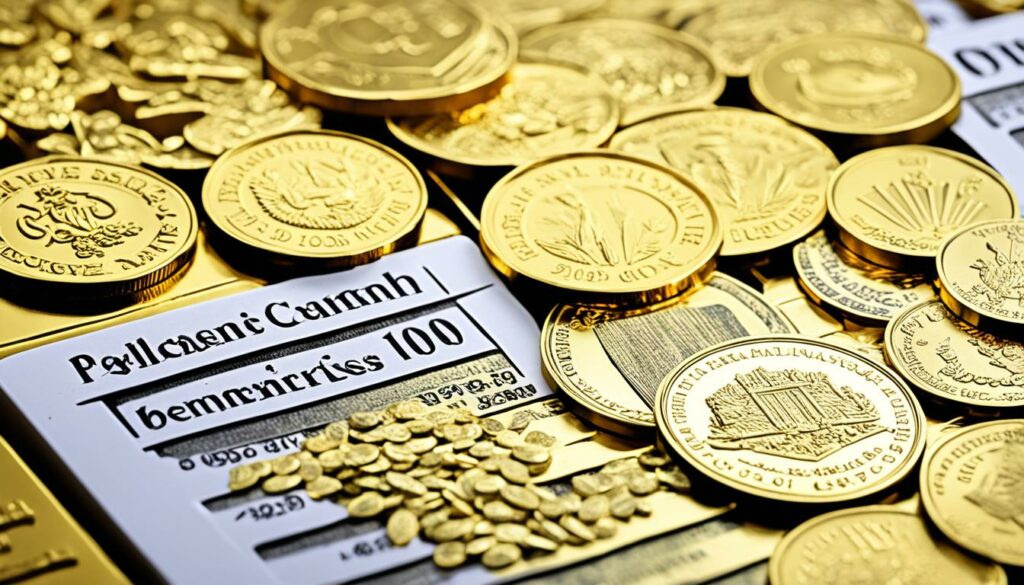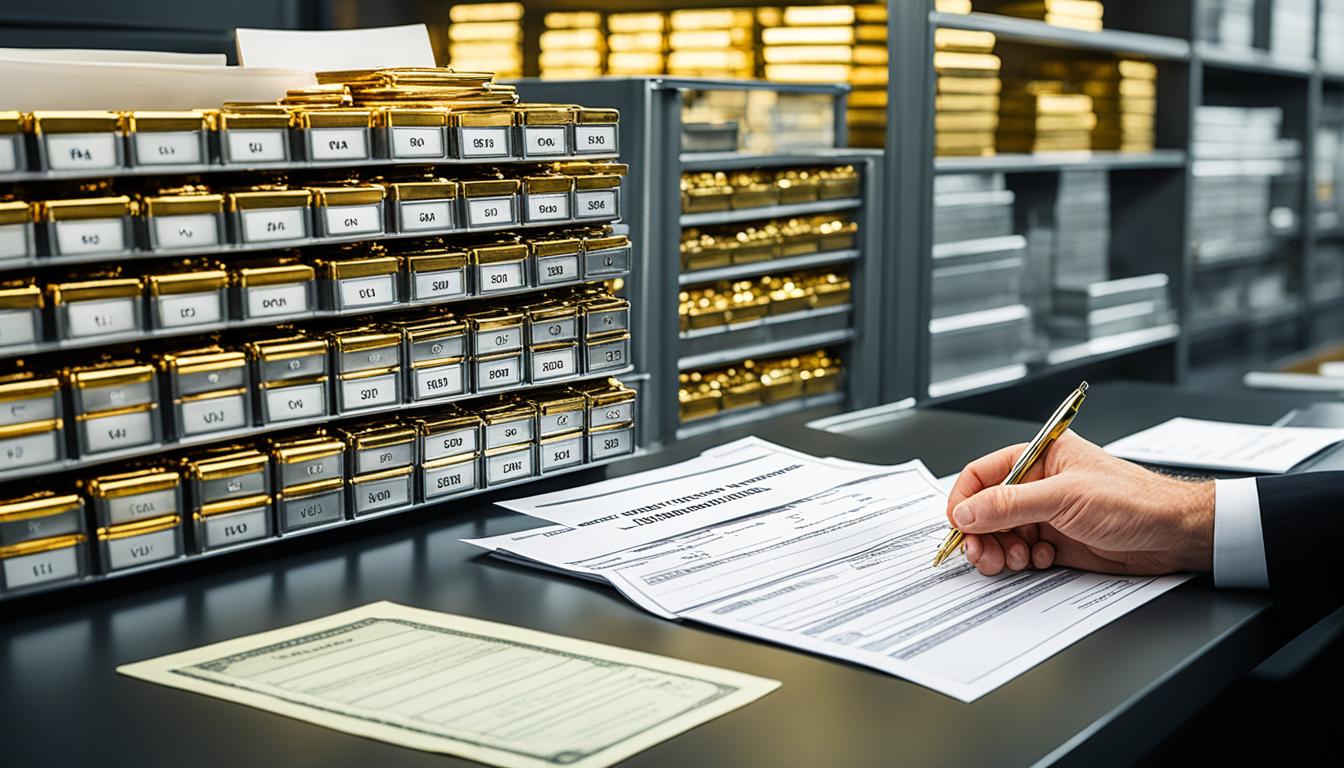Did you know that the global demand for gold coins and gold bars reached a staggering 1,290 metric tons in 2020? That’s equivalent to the weight of over 450 elephants!
When considering investing in physical gold, it’s essential to understand the differences between gold coins and gold bars. Both options have their own advantages and drawbacks, making it crucial to make an informed decision.
Key Takeaways:
- Gold coins and gold bars are popular options for investing in physical gold.
- Gold bars offer high purity levels and come in a variety of sizes.
- Gold coins have additional value as legal tender and possess historical significance.
- Prices per gram may vary between gold coins and gold bars.
- Storage and security considerations differ for gold coins and gold bars.
The Merits of Gold Bars
Gold bars offer several advantages for investors. They are known for their high purity levels, typically composed of 99.99% pure gold. This ensures that investors are obtaining gold of the highest quality, which is important for preserving value and ensuring authenticity. The purity of gold bars makes them highly desirable for investment purposes, as they are universally recognized and easily tradable.
One of the key merits of gold bars is the variety of sizes they are available in. Investors have the flexibility to choose the size of gold bars that best suits their investment goals and budgets. Whether it’s small bars weighing a few grams or larger bars weighing several kilograms, there is a wide range of options to cater to different investment needs. The availability of various sizes provides investors with the freedom to customize their gold investment and allocate their funds accordingly.
Furthermore, gold bars serve as an effective hedge against inflation. As a tangible asset with intrinsic value, gold has historically shown resilience during times of economic uncertainty. Inflation erodes the purchasing power of fiat currencies, but gold acts as a store of value that can offset the effects of inflation. By including gold bars in an investment portfolio, investors can mitigate the risks associated with inflation and preserve their wealth over the long term.
Gold bars also offer stability in an investment portfolio. Due to their high purity and intrinsic value, gold bars act as a reliable and durable asset. They can provide a sense of security and peace of mind to investors, especially during times of market volatility. Incorporating gold bars into a diversified portfolio can help reduce overall portfolio risk and enhance stability.
To summarize, the merits of gold bars lie in their high purity, variety of sizes, effectiveness as an inflation hedge, and stability in investment portfolios. These characteristics make gold bars an attractive choice for investors looking to diversify their portfolios and protect their wealth.
| Advantages of Gold Bars | |
|---|---|
| High purity: | Composed of 99.99% pure gold |
| Variety of sizes: | Investors can choose from a range of sizes |
| Inflation hedge: | Gold bars offer protection against inflation |
| Portfolio stability: | Gold bars provide stability in investment portfolios |

The Benefits of Gold Coins
When it comes to investing in physical gold, gold coins offer a range of unique benefits that make them a popular choice among investors. From their status as legal tender in many countries to their historical value and flexibility, gold coins can be a valuable addition to any investment portfolio.
Legal Tender and Additional Value
One of the key advantages of gold coins is their status as legal tender in many countries. This means that they are recognized and accepted as a form of currency, providing an additional layer of value beyond their intrinsic gold content. In times of economic uncertainty, the legal tender status of gold coins can offer reassurance and a practical means of exchange.
“Gold coins, being legal tender, can be used to make purchases and transactions in many countries, giving them a unique level of acceptance and value beyond their gold content.”
Historical and Traditional Significance
Gold coins also possess a rich history and traditional significance, which adds to their allure for collectors and enthusiasts. Many gold coins are minted with intricate designs that reflect a specific period in history or commemorate significant events. These numismatic attributes make gold coins not only a valuable investment but also a piece of tangible history.
Flexibility in Investment
When it comes to investment flexibility, gold coins offer distinct advantages. Unlike gold bars, which are typically sold in larger sizes, investors can buy and sell individual gold coins based on market conditions. This flexibility allows investors to adjust their investments according to their financial goals and the prevailing market dynamics.
Whether an investor wants to purchase a few gold coins for long-term wealth preservation or take advantage of short-term market opportunities, the ability to trade individual coins provides a level of flexibility that may not be as readily available with other forms of physical gold.

| Benefits of Gold Coins | Benefits of Gold Bars |
|---|---|
| Legal tender status provides additional value | High purity levels (99.99% pure gold) |
| Historical and traditional significance | Variety of sizes available |
| Flexibility in investment | Effective hedge against inflation |
Overall, gold coins offer a unique set of benefits that make them an attractive choice for investors seeking physical gold. Their legal tender status, historical value, and investment flexibility make gold coins a versatile asset class. As with any investment, it is important to consider individual financial goals, risk tolerance, and market conditions when choosing between gold coins and other forms of gold.
Price Comparison: Gold Coins vs Gold Bars
When considering investing in physical gold, one crucial factor to take into account is the price comparison between gold coins and gold bars. It’s important to understand how the prices per gram differ between these two forms of investment in order to make an informed decision.
The Cost of Gold Bars
Gold bars generally offer a lower price per gram compared to gold coins. This is because gold bars are often more basic in design and production, making them more cost-effective for manufacturers. The simplicity of their production process allows for lower production costs, which can be reflected in their market price.
“Gold bars typically have a lower price per gram compared to gold coins, thanks to their more straightforward design and manufacturing process. This makes them an attractive option for investors looking for a cost-effective investment in physical gold.”
However, it’s important to note that the price per gram can still vary depending on the size of the gold bar. Smaller gold bars, such as those weighing 10 grams or less, may be more expensive per gram compared to gold coins. This is because the cost of manufacturing and packaging smaller bars can offset the benefits of their simpler design. Investors should consider these factors when comparing prices.
The Price of Gold Coins
Gold coins, on the other hand, may have a higher price per gram compared to gold bars. This is partly because gold coins often possess additional value beyond their gold content. They may be considered legal tender in many countries, meaning they can be used as actual currency. This added value can contribute to a higher price per gram for gold coins.
Gold coins also hold historical significance and can be attractive to collectors, further influencing their price. The rarity, condition, and demand for specific gold coins can drive their market value, making them more valuable than the raw gold content they contain.
Considering the Price Comparison
When comparing the price per gram of gold coins and gold bars, it’s essential to consider individual investment goals and preferences. While gold bars generally offer a lower price per gram, gold coins may provide additional benefits such as historical value and potential for appreciation.
Investors should also consider factors such as market demand, collectability, and the potential for value increase when assessing the overall value of their investment. The decision between gold coins and gold bars should not be based solely on the price per gram, but on a comprehensive evaluation of the advantages and drawbacks of each form of investment.

Storage and Security Considerations
When it comes to storage and security, both gold coins and gold bars require careful consideration. However, due to their smaller size, gold coins offer a more manageable storage solution.
Gold coins can be easily stored in secure containers or safety deposit boxes, allowing investors to keep their precious metals protected. These smaller coins can also be concealed more discreetly, reducing the risk of theft or loss.
On the other hand, gold bars are larger and may necessitate more robust storage options. Investors may opt for professional gold storage facilities or vaults to ensure the highest level of security for their valuable assets.
Choosing the right storage method is essential to safeguarding your investment in precious metals, whether it be gold coins or gold bars.

Storage and Security Comparison
| Storage and Security Factors | Gold Coins | Gold Bars |
|---|---|---|
| Manageability | Easily stored in secure containers or safety deposit boxes. | Require more secure storage options like professional gold storage facilities or vaults. |
| Discreetness | Smaller size allows for more discreet storage options. | Larger size may limit discreet storage options. |
| Security | Can be securely stored to prevent theft or loss. | Require robust storage solutions for maximum security. |
Investment Flexibility: Gold Coins vs Gold Bars
When it comes to investing in physical gold, one important consideration is the investment flexibility offered by gold coins and gold bars. While both options have their merits, gold coins provide a greater level of flexibility for investors, thanks to their smaller size and wide variety of options.
Investors who choose gold coins benefit from the ability to adjust their investments by buying and selling individual coins. This flexibility allows for diversification within a gold investment portfolio. By holding a variety of gold coins, investors can spread their risk and potentially enhance their returns.
On the other hand, gold bars, while cost-effective and stable, may be less flexible in terms of adjusting investments. Due to their larger size, it can be more challenging to buy and sell smaller portions of gold bars. This can limit the ability to make precise adjustments to a gold investment portfolio when market conditions change.
To illustrate the investment flexibility of gold coins and gold bars, consider the following table:
| Investment Flexibility | Gold Coins | Gold Bars |
|---|---|---|
| Size | Small and varied sizes | Larger sizes |
| Diversification | Easy to buy and sell individual coins | Limited ability to buy and sell smaller portions |
| Adjusting Investments | Flexible to adjust investments based on market conditions | Less flexible due to larger size |
As shown in the table above, gold coins offer greater investment flexibility compared to gold bars. Their smaller size and variety make it easier for investors to make precise adjustments to their gold holdings and diversify their portfolio.
Ultimately, when it comes to investment flexibility, gold coins are a more versatile option for investors seeking to tailor their gold investments to meet their specific goals and market conditions.

Potential for Value Increase
One of the key factors to consider when deciding between gold coins and gold bars is the potential for value increase. Both options have their own unique characteristics that can impact their collectability and value over time.
Gold coins, with their historical significance and rarity, often possess a higher potential for appreciation. Collectors and enthusiasts are attracted to the unique designs, limited mintages, and the stories behind these coins. Additionally, the condition of gold coins can greatly affect their value, with well-preserved coins commanding higher prices.
On the other hand, gold bars primarily derive their value from their purity and the fluctuating gold spot price. As pure gold, they are highly sought after by investors looking to diversify their portfolios and protect their wealth. While gold bars may not have the same numismatic potential as gold coins, their value can still increase as the demand for gold rises.
It’s important to note that the potential for value increase in both gold coins and gold bars is influenced by various factors, including market conditions, global economics, and geopolitical events. Conducting thorough research and staying informed on industry trends can help investors make informed decisions about their precious metal investments.

Gold Coins vs Gold Bars: A Comparison
| Gold Coins | Gold Bars |
|---|---|
| Higher potential for value appreciation due to rarity and collectability | Value primarily based on purity and the gold spot price |
| Historical significance and unique designs attract collectors | Highly sought after by investors for wealth protection and diversification |
| Condition can greatly impact value | Uniform design and packaging |
| Flexibility in buying and selling individual coins | Large size may require specialized storage options |
Liquidity: Gold Coins vs Gold Bars
When it comes to the liquidity of gold coins and gold bars, both options offer easy buying and selling opportunities. There is a consistent buyer demand for both, making them readily available in the market.
Gold coins, with their smaller size, may have a slight advantage in terms of liquidity. They are often more accessible and can be easily sold due to their popularity among collectors and investors alike.
On the other hand, gold bars also possess desirable liquidity. These larger bullion bars are widely recognized and sought after by investors who prioritize bulk transactions and higher volumes.
While gold coins may have a larger market and be slightly easier to sell, gold bars still hold their own when it comes to liquidity. Both options provide ample opportunities for investors to enter and exit the market whenever desired.
The Role of Buyer Demand
Buyer demand plays a crucial role in the liquidity of gold coins and gold bars. The consistent interest from buyers ensures that there are always willing parties looking to purchase these precious metals.
“The buyer demand for gold coins and gold bars is a testament to the enduring appeal and intrinsic value of physical gold.”
– Industry Expert
This buyer demand contributes to the overall liquidity of gold coins and gold bars, enabling investors to convert their holdings into cash or other investments, if necessary.
Considerations for Investors
When considering liquidity as a factor in your investment decision, it’s important to assess your own requirements and preferences. Evaluate whether you prioritize a larger market presence or the ease of selling smaller-sized assets.
Furthermore, consider the potential resale value of gold coins and gold bars. While their liquidity is generally reliable, certain factors such as the design, rarity, and condition can impact the price at which they can be sold.
Ultimately, whether you choose gold coins or gold bars, rest assured that both options offer sufficient liquidity. It’s crucial to have a well-defined investment strategy and align your choice with your overall financial goals.
| Gold Coins | Gold Bars |
|---|---|
| Smaller size | Larger size |
| Popularity among collectors | Attractive to investors prioritizing bulk transactions |
| Wider market presence | Recognized worldwide |
| May command higher premiums | Potential lower premiums |

Tax Considerations: Gold Coins vs Gold Bars
When investing in gold, it’s important to take tax considerations into account, as they can impact your overall return on investment. Whether you choose to invest in gold coins or gold bars, understanding the tax implications is crucial.
Gold coins may be exempt from Value Added Tax (VAT) in certain jurisdictions, making them more tax-efficient compared to gold bars. VAT is a consumption tax that is added to the purchase price of goods and services. The exemption of gold coins from VAT reduces the upfront cost of investing in gold coins, making them an attractive option for investors concerned about taxes.
| Tax Considerations | Gold Coins | Gold Bars |
|---|---|---|
| VAT | Exempt in certain jurisdictions | May also be VAT-free in some cases |
| Capital Gains Tax (CGT) | May apply when selling gold coins | May apply when selling gold bars |
On the other hand, gold bars may also be exempt from VAT in some cases. It’s important to consult with a tax professional or review the tax regulations in your jurisdiction to fully understand the VAT exemptions for both gold coins and gold bars.
Additionally, Capital Gains Tax (CGT) may apply when selling gold coins or gold bars, depending on the jurisdiction and the profit made from the sale. CGT is a tax imposed on the gain achieved from the sale of an asset. It is important to consider the potential CGT liability when planning to sell your gold investments.
Ultimately, the tax considerations for gold coins and gold bars may vary depending on your location and the specific tax regulations in place. It is recommended to seek advice from a financial advisor or tax professional to fully understand the tax implications of your gold investments.

Conclusion
When it comes to investing in physical gold, the decision between gold coins and gold bars depends on individual preferences and investment strategies. Both options have their own unique advantages and considerations to keep in mind.
Gold coins offer flexibility as they can be easily bought and sold individually. They also hold collectability value and have the potential for appreciation over time. Gold coins are ideal for investors who value the historical significance and the ability to adjust their investment based on market conditions.
On the other hand, gold bars provide cost-effectiveness and stability. They are typically composed of high purity gold and serve as a long-term value preservation option. Gold bars are a great choice for investors looking for a secure and tangible investment.
Ultimately, a well-rounded investment strategy may include a combination of both gold coins and gold bars. Consider factors such as price, storage, investment flexibility, potential value increase, liquidity, and tax considerations to make an informed decision. By carefully evaluating these factors, investors can create a diversified portfolio that includes physical gold in the form that best aligns with their financial goals.









